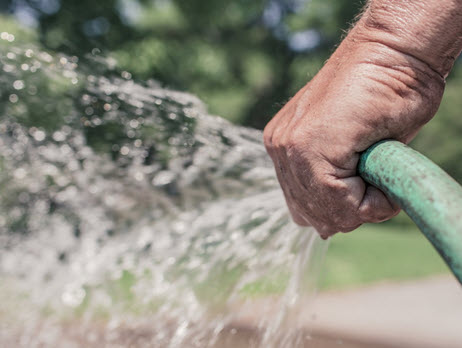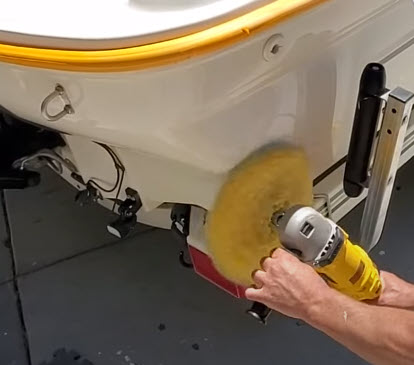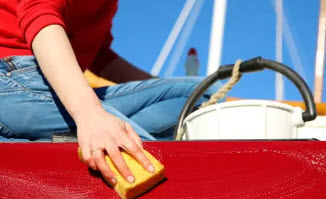Welcome to todays’ post about how to buff gelcoat on a boat, you’ll learn all the tips and tricks so you’ll be buffing like a pro in no time.
Gelcoat is a specially formulated material applied to the exterior of fiberglass boats and other composite structures. It serves both aesthetic and protective functions.
Typically, gelcoat is the outermost layer of a fiberglass laminate, providing a smooth and glossy finish. Its primary role is to protect the underlying fiberglass from water intrusion, UV radiation, and physical damage while enhancing the overall appearance of the boat.
Table of Contents
The Purpose of Gelcoat Buffing
Buffing the gelcoat is the process of mechanically polishing the surface. It involves using abrasive compounds and pads to smooth out imperfections, restore shine, and eliminate discoloration.

Over time, gelcoat can become dull, scratched, or faded due to exposure to environmental factors, such as UV rays, saltwater, pollutants, and general wear and tear. Buffing removes oxidation and brings back the gelcoat’s shine and colour, revitalizing the boat’s appearance.
The Effect of Weather Conditions on Gelcoat
Weather conditions play a significant role in the deterioration of gelcoat. Prolonged exposure to sunlight can cause oxidation, making the gelcoat appear chalky or dull.
Additionally, constant exposure to saltwater, rain, and environmental pollutants can cause staining or discoloration. Temperature fluctuations and moisture exposure may lead to cracks or blisters in the gelcoat.
Regular maintenance and buffing can help mitigate these weather-induced effects and prolong the lifespan of the gelcoat.
Signs Your Boat’s Gelcoat May Need to be Buffed
- Dull Appearance: If the gelcoat has lost its shine and appears dull, it might be due to oxidation, which can often be resolved through buffing.
- Discoloration: Yellowing or discoloration of the gelcoat is a sign of UV damage or staining, which can be addressed through buffing and polishing.
- Surface Imperfections: Scratches, small cracks, or surface imperfections can accumulate over time and may require buffing to restore the smooth finish.
- Chalky Texture: Oxidation can give the gelcoat a chalky or powdery texture. Buffing can remove this layer, revealing the original glossy surface.
- Staining or Water Spots: Environmental pollutants, minerals in water, and salt residue can cause stains or water spots. Buffing can help remove these blemishes.
Regularly inspecting the gelcoat for these signs and performing periodic buffing when needed is essential to maintain the boat’s appearance and protect the underlying fiberglass structure.
Supplies Required for Gelcoat Buffing:
- Buffer/Polisher Machine: A dual-action buffer/polisher with variable speed settings is ideal for gelcoat. Consider rotary or random orbital machines. Brands like Rupes, Flex, or DeWalt offer good options.
- Buffing Pads: Foam pads of varying coarseness (cutting, polishing, and finishing pads) are needed for different stages of the process. These pads come in different colours indicating their abrasiveness.
- Compound/Polishing Compounds: Compounds with varying levels of abrasiveness are required for cutting, polishing, and finishing. Choose marine-grade compounds suitable for gelcoat restoration. Brands like 3M, Meguiar’s, or Presta offer quality compounds.
- Microfiber Towels: Used for wiping off excess compounds and for final polishing.
- Protective Gear: Safety goggles, dust mask/respirator, gloves, and appropriate clothing to protect yourself from chemicals and fine particles during the buffing process.
- Clean Water and Hose: Essential for rinsing the surface before and after buffing.
- Cleaner/Wax: To apply after the buffing process to protect the gelcoat and enhance shine.

Buying Guide for Selecting the Best Supplies:
- Buffer/Polisher Machine: Look for models with variable speed settings and a reputation for being gentle on gelcoat. Consider user reviews and expert recommendations for the best results.
- Buffing Pads: Choose pads specifically designed for gelcoat and appropriate for your buffer. Ensure you have different pads for each stage of the process (cutting, polishing, and finishing).
- Compounds: Select marine-grade compounds suitable for gelcoat. Opt for compounds that offer a range of abrasiveness levels to cater to different levels of oxidation and damage.
- Microfiber Towels: Choose high-quality, lint-free microfiber towels for effective wiping and polishing.
- Protective Gear: Invest in quality safety gear to protect yourself during the process. Ensure your gear is suitable for chemical handling and protects against fine particles.
Safety Guidelines when Handling Gelcoat Buffing Tools:
- Ventilation: Work in a well-ventilated area to minimize exposure to fumes and particles. Consider using a respirator or mask if ventilation is insufficient.
- Protective Gear: Wear safety goggles to protect your eyes from splashes, dust, and debris. Gloves and appropriate clothing will shield your skin from chemicals.
- Read Instructions: Familiarize yourself with the equipment and compounds. Follow manufacturer guidelines for usage and safety precautions.
- Test in a Small Area: Before starting the entire boat, test the buffing process in a small, inconspicuous area to ensure the chosen compounds and pads don’t damage the gelcoat.
- Cleanliness: Keep the work area clean and organized. Avoid cross-contamination between different compounds and pads.
- Avoid Overheating: Do not keep the buffer in one area for too long as it can generate excess heat, potentially damaging the gelcoat.
- Follow Proper Techniques: Research and follow proper buffing techniques to achieve the best results without causing harm to the gelcoat surface.
Always prioritize safety and proper handling of equipment and chemicals when engaging in gelcoat buffing to ensure the best results without compromising your well-being or the boat’s surface.
Step-by-Step Guide to Gelcoat Buffing:
Before we get into the process of how to buff gelcoat on a boat we need to make sure the boat is ready.
Preparing Your Boat for the Process:
- Wash the Boat: Thoroughly clean the boat to remove any dirt, grime, or salt residue using a mild detergent or boat soap. Rinse well and let it dry completely.
- Masking Off Areas: Use painter’s tape to cover areas you don’t want to accidentally buff, such as decals, fittings, or non-gelcoated surfaces.
- Inspection: Inspect the gelcoat for any damages, scratches, or deep gouges. Address major damage separately before starting the buffing process.
Applying the Compound: Tips and Techniques:
- Start with the Least Abrasive Option: Begin with the least aggressive compound and pad combination to test its effectiveness. Apply a small amount of compound to the pad.
- Work in Sections: Divide the boat into manageable sections and work on one area at a time. Apply the compound onto the gelcoat in a small, circular motion.
- Controlled Pressure: Apply light to moderate pressure on the buffer. Let the machine do the work; excessive pressure can damage the gelcoat.
- Overlap and Consistent Movements: Move the buffer in overlapping passes to ensure even coverage and avoid creating buffer marks. Maintain a consistent speed and keep the buffer flat against the surface.
- Regularly Check Progress: Periodically stop and wipe the area with a microfiber towel to inspect the progress. Repeat the process if necessary until the desired shine is achieved.
The Role of Wet Sanding in Gelcoat Buffing:
Wet sanding is an advanced technique used for severe oxidation or to address deeper scratches. It involves sanding the gelcoat with increasingly finer sandpaper while using water as a lubricant. It’s crucial to start with a coarser grit (around 800-1000) and gradually move to finer grits (2000-3000) to remove imperfections.
Proper Way of Using a Buffer:
- Buffer Selection: Attach the appropriate pad (for cutting, polishing, or finishing) to the buffer based on the stage of the process.
- Adjust Speed Settings: Start at a low speed to spread the compound evenly, gradually increasing the speed if necessary. Different machines may have different optimal speed ranges.
- Hold the Buffer Correctly: Hold the buffer firmly but not too tightly to allow some movement. Keep it level against the surface to avoid creating uneven spots.
- Keep Moving: Avoid lingering in one spot for too long, as it can cause damage due to excess heat and friction. Keep the buffer moving at all times.
- Clean the Buffer and Change Pads: Regularly clean the pad or change to a fresh pad to avoid reapplying residue or contaminants to the gelcoat surface.

Remember, practice and patience are key to achieving the best results with gelcoat buffing. It’s essential to start with the least aggressive methods and gradually increase the intensity if needed. If you’re unsure, consider seeking professional assistance to avoid potential damage to the gelcoat.
Common Mistakes to Avoid While Buffing Gelcoat:
Misjudging the Gelcoat’s Condition: Over-buffing and Under-buffing:
- Over-Buffing: Applying excessive pressure or using overly aggressive compounds on gelcoat that doesn’t require such treatment can lead to unnecessary removal of the protective gelcoat layer. This can thin the surface, leading to quicker deterioration and a shorter lifespan.
- Under-Buffing: Failing to address the actual level of oxidation or damage might result in an incomplete restoration. This could leave the gelcoat with a patchy or uneven appearance, as some areas may still show signs of wear or discoloration.
Risks of Not Using the Right Tools or Compounds:
- Wrong Tools: Using the incorrect buffer, pads, or compounds for gelcoat can cause damage. Aggressive compounds meant for other surfaces can be too abrasive and harm the gelcoat. Similarly, improper pads or buffers not designed for gelcoat can leave swirls, marks, or scratches on the surface.
- Inappropriate Compounds: Using compounds that are too aggressive for minor oxidation can strip away more gelcoat than necessary. Conversely, using a compound that’s too mild for severe oxidation might not effectively restore the gelcoat.
Impacts of Skipping Safety Measures:
- Health Hazards: Not using proper safety gear can lead to health issues. Chemical compounds and fine particles generated during buffing can be harmful if inhaled or come into contact with the skin or eyes.
- Potential Damage to the User: Buffing machines can be powerful and might cause accidents or injuries if not handled correctly. Without proper eye protection, there’s a risk of chemicals or debris getting into the eyes.
- Environmental Impact: Skipping safety measures might lead to spills or improper disposal of compounds and pads, causing environmental harm.
Best Practices to Avoid These Mistakes:
- Evaluate Gelcoat Condition: Carefully assess the level of damage and oxidation. Start with the least aggressive approach and work your way up if necessary.
- Use the Right Tools and Compounds: Ensure you have the correct buffers, pads, and compounds specifically designed for gelcoat. Consider professional advice if unsure about the suitable products.
- Follow Safety Guidelines: Always wear appropriate safety gear, work in a well-ventilated area, and follow the recommended safety measures to protect yourself and the environment.
By avoiding these common mistakes, you can ensure a more effective and safer gelcoat buffing process, maintaining the integrity and appearance of your boat while safeguarding your own health and the environment. If uncertain, consider seeking professional assistance to handle the gelcoat restoration.
Maintaining Your Gelcoat Post-Buffing:
Best Practices in Cleaning and Maintaining Gelcoat after Buffing:

- Regular Cleaning: Wash the gelcoat frequently with a mild detergent or a boat-specific soap to remove dirt, salt residue, and environmental pollutants. Rinse thoroughly to prevent any residue buildup.
- Avoid Harsh Cleaners: Refrain from using abrasive cleaners or harsh chemicals that could damage the gelcoat’s finish. Stick to gentle, boat-specific cleaning products.
- Waxing and Protecting: Apply a high-quality marine wax or polish to the gelcoat after buffing. This provides an additional layer of protection against UV rays and environmental elements while enhancing the shine. Reapply the wax or polish according to the manufacturer’s recommendations.
Choosing the Right Products for Gelcoat Care:
- Gelcoat-Specific Cleaners: Opt for cleaning products explicitly formulated for gelcoat. These are designed to clean without damaging the surface.
- Marine Waxes or Sealants: Choose high-quality marine waxes or sealants designed for gelcoat. These products protect the surface from UV rays, saltwater, and environmental contaminants.
- UV Protectants: Consider UV protectant products specifically made for gelcoat to reduce UV damage and fading.
Routine Monitoring and Maintenance Schedule to Maximize Gelcoat Lifespan:
- Regular Inspections: Periodically check the gelcoat’s condition for signs of oxidation, discoloration, or damage. Address any issues promptly to prevent further deterioration.
- Scheduled Cleaning: Establish a routine cleaning schedule, especially after boating trips or exposure to harsh conditions. Regular cleaning prevents the buildup of salt, grime, or pollutants that can damage the gelcoat.
- Seasonal Maintenance: Conduct more thorough inspections and maintenance at the beginning and end of each boating season. Address any issues and reapply protective coatings as needed.
- Proper Storage: If possible, store the boat in a covered area or using a boat cover to shield it from prolonged exposure to the elements, thus extending the lifespan of the gelcoat.
Remember, the key to maintaining the gelcoat’s appearance and prolonging its lifespan is regular care and protection. Consistent cleaning, proper use of protective coatings, and routine inspections go a long way in preserving the gelcoat’s quality and appearance.
Conclusion
Maintaining the gelcoat of your boat is crucial for preserving its appearance and structural integrity. The gelcoat serves as a protective layer against environmental elements, and proper care ensures its longevity.
By now you’ll know how to buff gelcoat on a boat the right way.
Buffing the gelcoat rejuvenates its shine and removes imperfections caused by exposure to UV rays, saltwater, and general wear and tear.
Understanding the gelcoat’s condition, using the right tools and compounds, and implementing safety measures during buffing are critical to avoid common mistakes that might lead to over-buffing, under-buffing, or potential damage.
A step-by-step approach involving thorough preparation, proper application of compounds, and the use of suitable buffers is key to achieving successful gelcoat restoration.
Post-buffing maintenance is equally essential. Regular cleaning with mild detergents, applying marine waxes or sealants, and using gelcoat-specific products aid in protection against UV rays and environmental elements.
Periodic inspections, seasonal maintenance, and proper storage practices also contribute significantly to extending the gelcoat’s lifespan.
In conclusion, a well-maintained gelcoat not only enhances the aesthetics of your boat but also safeguards its structure.
By following best practices in buffing, cleaning, and routine maintenance, you can ensure your boat’s gelcoat remains in optimal condition, allowing you to enjoy its beauty and durability for years to come.
